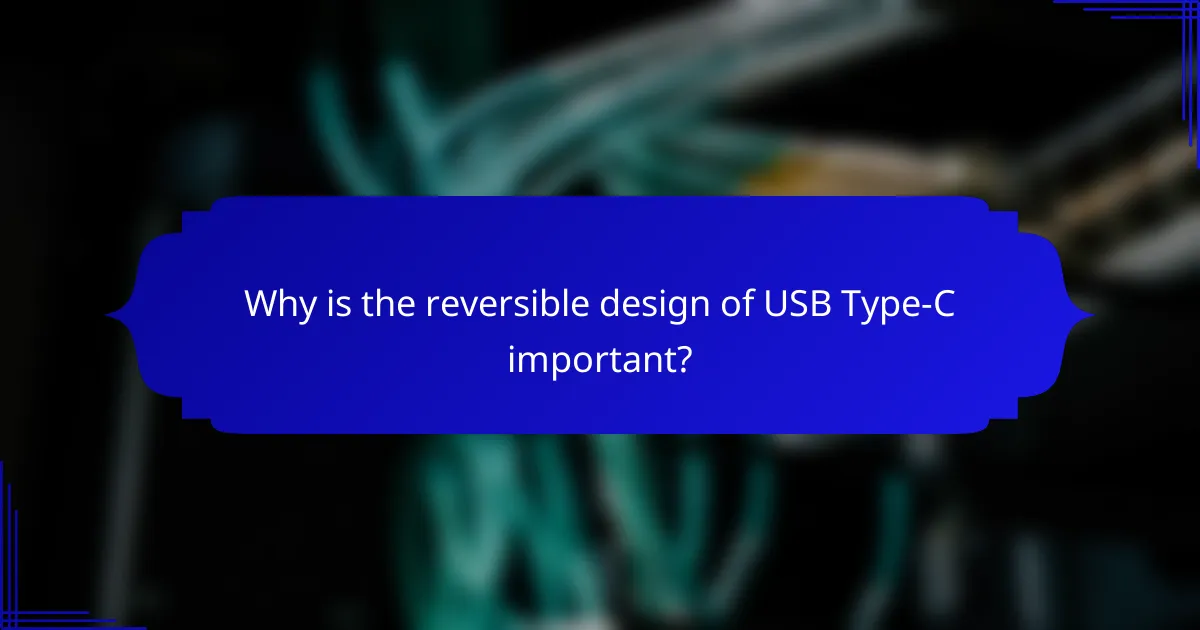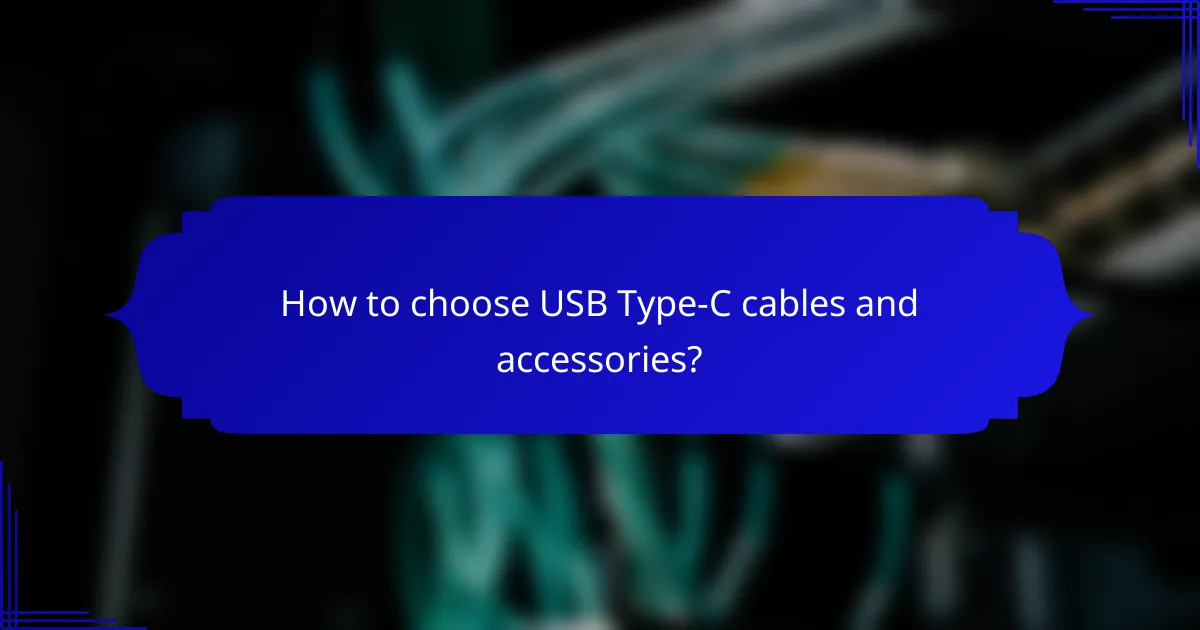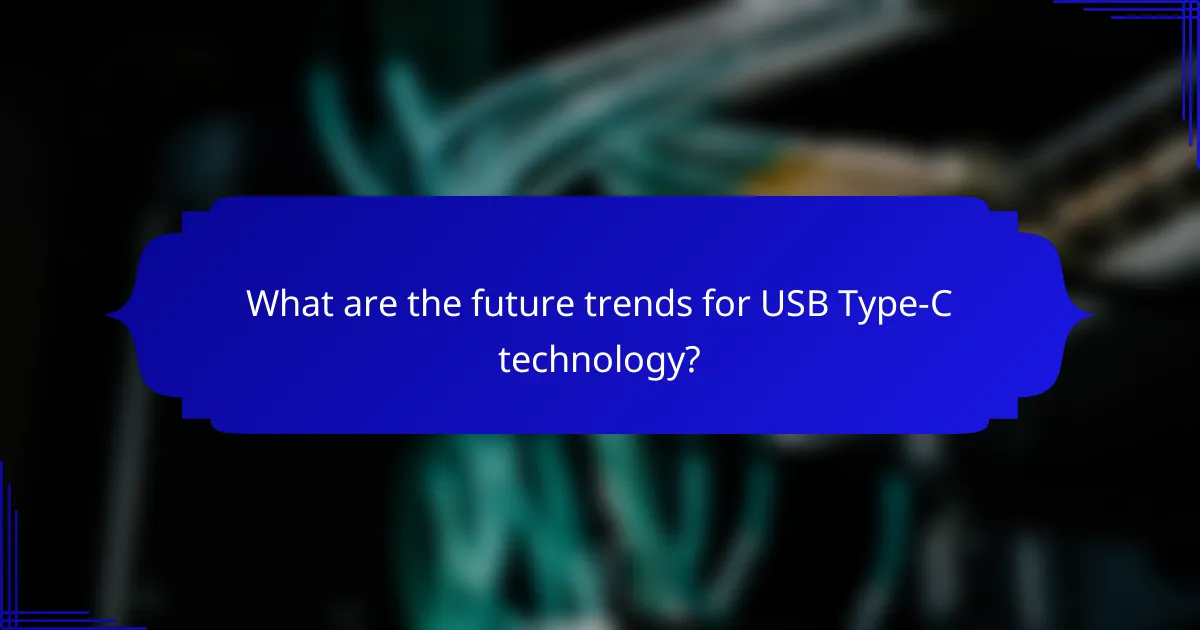USB Type-C is revolutionizing connectivity with its versatile design, enabling a single connector to serve multiple devices and applications. Its reversible feature simplifies connections, while power delivery capabilities enhance charging speed and efficiency, making it an ideal choice for modern electronics.

How does USB Type-C enhance device versatility?
USB Type-C enhances device versatility by providing a single, unified connector that can be used across a wide range of devices and applications. Its reversible design and support for various functionalities make it a practical choice for both consumers and manufacturers.
Universal compatibility with devices
USB Type-C is designed to be universally compatible with a multitude of devices, including smartphones, laptops, tablets, and peripherals. This compatibility reduces the need for multiple cables and adapters, streamlining the user experience.
For instance, a single USB Type-C cable can charge a laptop while also transferring data to an external hard drive. This versatility simplifies connectivity and enhances convenience in everyday use.
Support for multiple protocols
USB Type-C supports various protocols, including USB Power Delivery (PD), DisplayPort, and Thunderbolt, allowing for a range of functionalities beyond simple data transfer. This means users can enjoy faster charging, high-definition video output, and quick data transfers all through one port.
For example, with USB Power Delivery, devices can negotiate power levels up to 100 watts, enabling rapid charging for larger devices like laptops. This capability is particularly useful for users who require efficient power management.
Compact design for portability
The compact design of USB Type-C connectors makes them ideal for portable devices. Their slim profile allows manufacturers to create thinner and lighter devices without sacrificing functionality.
This design is especially beneficial for mobile devices, where space is at a premium. Users can easily carry USB Type-C cables and accessories without the bulk typically associated with older connectors.

What are the benefits of USB Type-C power delivery?
USB Type-C power delivery offers significant advantages, including faster charging, the ability to power larger devices, and improved energy efficiency. These features make it a versatile option for modern electronics, enhancing user convenience and device performance.
Faster charging capabilities
USB Type-C power delivery can deliver power at rates up to 100 watts, allowing devices to charge much quicker than traditional USB standards. For example, a smartphone can often reach a full charge in under an hour, while laptops may charge significantly faster compared to standard chargers.
To take advantage of faster charging, ensure that both the device and the charger support USB Power Delivery (PD). Using a compatible cable is also crucial, as not all USB Type-C cables can handle high power levels.
Powering larger devices
USB Type-C power delivery is capable of powering larger devices such as laptops, monitors, and even some gaming consoles. This capability eliminates the need for multiple power adapters, simplifying the charging process for users.
When using USB Type-C for larger devices, check the power requirements to ensure compatibility. Many laptops now come with USB-C ports that support power delivery, making it easier to use a single charger for multiple devices.
Energy efficiency advantages
USB Type-C power delivery is designed to be more energy-efficient than previous USB standards. It minimizes energy loss during charging, which can lead to lower electricity bills and a reduced carbon footprint over time.
Additionally, devices can negotiate power requirements, ensuring they only draw the necessary amount of power. This feature not only conserves energy but also enhances battery lifespan by reducing heat generation during charging.

Why is the reversible design of USB Type-C important?
The reversible design of USB Type-C is crucial because it allows users to connect devices without worrying about the orientation of the connector. This feature enhances convenience and usability, making it easier to plug in cables in any position.
Ease of use with no orientation needed
The USB Type-C connector can be inserted either way, eliminating the frustration of trying to determine the correct orientation. This simplicity is especially beneficial in low-light conditions or when users are in a hurry. As a result, it streamlines the process of connecting devices, whether it’s a smartphone, laptop, or peripheral.
Reduced wear on ports
With the reversible design, users are less likely to force the connector into the port incorrectly, which can lead to damage over time. This reduction in improper connections helps maintain the integrity of both the cable and the device’s port. Consequently, users can expect a longer lifespan for their devices and accessories.
Improved user experience
The convenience of a reversible connector significantly enhances the overall user experience. Users can quickly and easily connect their devices without the hassle of fumbling with the cable. This small but impactful design choice contributes to a more seamless interaction with technology, making daily tasks more efficient.

What devices commonly use USB Type-C?
USB Type-C is widely adopted across various devices, providing a versatile connection standard for charging and data transfer. Common devices include smartphones, laptops, and tablets, all benefiting from its reversible design and power delivery capabilities.
Smartphones like Apple iPhone 15
The Apple iPhone 15 utilizes USB Type-C for charging and data transfer, marking a significant shift from previous models that used the Lightning connector. This change allows for faster charging and compatibility with a broader range of accessories.
When using USB Type-C with the iPhone 15, users can expect power delivery that supports rapid charging, potentially reaching up to 50% charge in around 30 minutes with the right adapter. Ensure to use certified cables to avoid compatibility issues.
Laptops such as Dell XPS 13
The Dell XPS 13 features USB Type-C ports that support both charging and high-speed data transfer. This allows users to connect various peripherals, including external monitors and storage devices, using a single cable.
For optimal performance, consider using USB Type-C hubs that provide additional ports for HDMI, USB-A, and Ethernet connections. Be aware that not all USB Type-C ports support the same power delivery levels, so check the specifications for your model.
Tablets including Samsung Galaxy Tab S8
The Samsung Galaxy Tab S8 employs USB Type-C for charging and connecting to accessories, enhancing its versatility as a productivity tool. This tablet supports fast charging, enabling users to quickly power up their device during busy days.
Users should utilize high-quality USB Type-C cables to ensure efficient charging and data transfer. The Galaxy Tab S8 can also connect to external displays, making it suitable for presentations or media consumption.

How to choose USB Type-C cables and accessories?
Choosing USB Type-C cables and accessories involves understanding their specifications, compatibility, and reliability. Focus on power ratings, data transfer speeds, and the reputation of brands to ensure you select the right products for your needs.
Understanding power ratings
Power ratings indicate how much electrical power a USB Type-C cable can deliver. Look for cables that support Power Delivery (PD) standards, which can range from 18W to over 100W, depending on your device’s requirements. Higher wattage ratings are essential for charging laptops and other high-power devices efficiently.
When selecting a cable, ensure it matches the power needs of your devices. For example, a smartphone may only require 18W, while a laptop might need 60W or more. Using a cable with a lower rating than required can lead to slow charging or potential damage.
Identifying data transfer speeds
Data transfer speeds for USB Type-C cables vary significantly, with options ranging from USB 2.0 (up to 480 Mbps) to USB 3.2 and Thunderbolt 3 (up to 40 Gbps). For tasks like transferring large files or streaming high-resolution video, opt for cables that support higher speeds.
Check the specifications on the packaging or product description to ensure compatibility with your devices. If you frequently transfer large amounts of data, investing in a cable that supports USB 3.1 or higher is advisable for optimal performance.
Recognizing brand reliability
Brand reliability is crucial when choosing USB Type-C cables and accessories. Established brands often provide better quality control, customer support, and warranties. Look for brands known for their durability and performance in the tech community.
Read reviews and check ratings from other users to gauge the reliability of a product. Avoid generic or unbranded options, as they may not meet safety standards and can lead to device damage or data loss.

What are the future trends for USB Type-C technology?
Future trends for USB Type-C technology include wider adoption across various devices and advancements in power delivery capabilities. As manufacturers continue to integrate USB Type-C into their products, users can expect improved compatibility and faster charging options.
Increased adoption in consumer electronics
USB Type-C is rapidly becoming the standard connector for consumer electronics, including smartphones, laptops, and tablets. This trend is driven by its versatility, allowing for data transfer, video output, and power delivery through a single port.
Major brands are transitioning to USB Type-C, with many new devices no longer including legacy ports. This shift simplifies connectivity for users, as they can use the same cable for multiple devices, reducing clutter and enhancing convenience.
As more devices adopt USB Type-C, consumers should consider investing in high-quality cables and accessories to ensure optimal performance. Look for cables that support the latest USB specifications to take full advantage of faster charging and data transfer rates.
